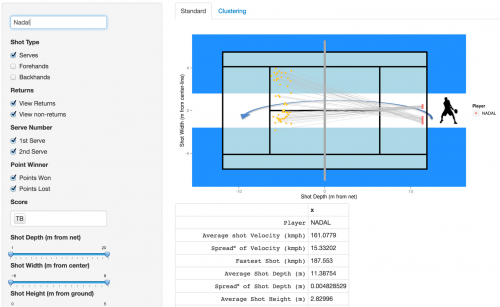How Hawk-Eye ball tracking can improve tennis performance

The evolution of professional tennis has always been linked to the changing technology of the day. For example, the decline of the wooden racket lead to the whole new power-based style of play we enjoy today.
One of the more recent introductions to have significant impact is Hawk-Eye ball tracking.
It's certainly transformed the way we watch and adjudicate tennis. But can we go further and utilise this truly awesome technology to improve the on-court performance of the competitions elite?
The traditional use of Hawk-eye
Hawk-Eye is a computer vision based technology that allows the trajectory of a ball and players to be tracked purely from video. The advantage of such a system is that it's completely un-intrusive, you don't need to put sensors in anything.
It's mostly used to make line-calls, as a back-up when players object to the call made by a lines referee. It's also used by broadcasters to provide a general overview of a game, set or match.
Its introduction has seen some debate, but it was nonetheless approved for use at tour level by the International Tennis Federation (ITF) in 2005, after the 2004 US Open Women quarter-final – when Serena Williams lost to Jennifer Capriati – was marred by a series of dubious line calls..
In this application, it solves a real problem. It eliminates the human element of line-calling, Hawk-Eye doesn't feel pressure on big points. It doesn't come cheap, one report from 2011 putting the cost between US$60,000 and US$70,000 per court to operate, another report this year put that figure at US$100,000 a court.
It's hard to argue the cost isn't worth it just for line calls, it would be hard to see us going back to a world where we don't use ball tracking. But Hawk-Eye isn't just good for line-calls.
More to Hawk-Eye than line calls
Fans only ever really see the brief interaction between ball and court, but Hawk-Eye sees far more.
By collecting data over the entire trajectory of every shot played on Australian show-courts this summer, Tennis Australia (TA) is amassing richer data sources than ever.
At this year's Australian Open, Hawk-Eye based insights as a tool for pre-match opposition analysis will be greater utilised than ever before by Tennis Australia's High-Performance unit.
Hawk-Eye has been deployed on multiple courts at the Australian Open and AO series events (Brisbane and Sydney for example) since 2007, and as such we have tracking data for some 250 tennis players.
Thanks partially to funding from an Australian Institute of Sport (AIS) grant, an app (like the ones on your favourite smart-phone) has been constructed using open source technologies with Hawk-eye data at its core.
Coaches can log-in from anywhere in the world, and interactivity sort and visualise data, tapping into their unique expertise without the need to consult the performance analysis team every time they want to delve deeper into the data.
The above shows part of a typical output for the applet. In this case, only serves hit (from right to left) by Rafael Nadal during tie-breaks are selected. We can see clearly in this case where Rafa's favourite serve to the deuce side is down the middle, rather than to the side.
The app is essentially a "Google for tennis coaches", a tie breaker if you will. Ever wondered who hits off-forehands faster, Nadal or Roger Federer? (Nadal by 4kmph) Or who gets a higher net-clearance on serves to the advantage side of the court? (Nadal by half a centimeter), or who hits backhands deeper at 30-40? (Federer by 60cm).
These aren't debates anymore, and TA coaches can definitively answer questions like these and more at the tap of an app. These insights can be used in a multitude of situations, from planning for a grand-slam opponent to goal-setting for developing athletes.
For example, a coach may suspect a developing athlete is too cautious serving on break point 2nd serves. The coach can use the app, on court from a tablet or phone, to quickly derive typical serve speeds under that exact scenario for a multitude of top players.
Such data quickly eliminates any debate that the hypothetical athlete just doesn't measure up to the competition, and that they should work on that area of their game.
Moving beyond 'stats'
There's more to analytics than just stats though, much more. Stats are great but they can often be miss-leading and are almost always misinterpreted. (As Homer Simpson so eloquently put it: "You can use facts (stats) to prove anything that's even remotely true".)
A growing area of data-science is Machine Learning, where you quite literally build simple Artificial Intelligence (AI) algorithms inside computers, which commit large sets of observations to memory and find patterns within, essentially by trial and error.
These algorithms mimic the way we learn, to the extent that one of the most historically successfully algorithms – the artificial neural-network – has structure heavily inspired by that of our own brains.
Machine learning algorithms have been adapted to use Hawk-Eye data in an attempt to uncover trends within matchplay. The result is a "little black book" of potential match-day strategies, which could provide an edge in competition. TA coaches are able to draw on such insights where they see fit as part of the preparation for an opponent.
The system is still very much in development, but has been implemented in some top-level competition. For example, insights derived from data were presented to the player-group prior to Australia's 2014 Davis cup win over Uzbekistan.
So whether you like it or not, we are heading rapidly into the information age and how we collect and use data is taking over every aspect of our lives.
Sport – and tennis – is no exception.
Source: The Conversation
This story is published courtesy of The Conversation (under Creative Commons-Attribution/No derivatives).
![]()



















